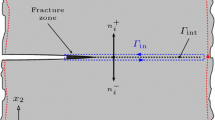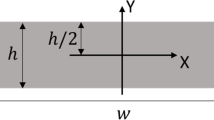Abstract
This paper presents a numerical method well suited to solve the integral equation governing the asymptotic behavior of a cohesive crack, and uses it to analyze the influence of the softening curve on the cracking response of large specimens. The analysis is performed with two main objectives in mind: (1) providing criteria to determine when a simplified linear elastic fracture mechanics (LEFM) approach can be applied, and (2) providing possible procedures of extracting information on the softening behavior from experimental data. The main conclusion is that the effective crack extension prior to peak is nearly determined by the length of the softening curve (the critical crack opening) and so is the deviation from LEFM. Furthermore, a simplified ℛ curve approach is proposed as an approximate alternative to solving the governing integral equation.
Similar content being viewed by others
References
G.J. Barenblatt, Advances in Applied Mechanics 7 (1962) 55–125.
D.S. Dugdale, Journal of Mechanics and Physics of Solids 8 (1960) 100–104.
A. Hillerborg, M. Modeer and P.E. Petersson, Cement and Concrete Research 6 (1976) 773–782.
A. Hillerborg, Materials and Structures (1985) 291–296.
R.F. Cook, C.F. Fairbanks, B.R. Lawn and Y.W. Mai, Journal of Materials Research 2 (1987) 345–356.
R.W. Steimbretch, A. Reichl and W. Schaarwächter, Journal of the American Ceramics Society 73 (1990) 2009–2015.
J. Planas and M. Elices. Anales de Mecánica de la Fractura 3 (1986) 219–227.
J. Planas and M. Elices, International Journal of Fracture 55 (1991) 153–177.
J. Planas and M. Elices, International Journal of Fracture 51 (1991) 139–157.
E. Smith, The elastically equivalent softening zone size for an elastic-softening material: II. A simple piece-wise softening law, submitted for publication.
E. Smith, When can we apply LEFM principles to elastic softening materials?, submitted for publication.
A. Castro-Montero, S.P. Shah and R.A. Miller. Journal of Engineering Mechanics, ASCE 116 (1990) 2463–2484.
R.A. Miller, A. Castro-Montero and S.P. Shah, Journal of the American Ceramics Society 74 (1991) 130–138.
H. Horii and T. Ichinomiya, International Journal of Fracture 51 (1991) 19–29.
J.J. Du, A.S. Kobayashi and N.M. Hawkins, Engineering Fracture Mechanics 35 (1990) 15–27.
M. Elices and J. Planas, International Journal of Fracture 61 (1993) 159–172.
J. Planas, M. Elices and G. Ruiz, International Journal of Fracture 61 (1993) 231–246.
H. Tada, P. Paris and G. Irwin, The Stress Analysis of Cracks Handbook, Del Research Corp. (1985).
K. Rokugo, M. Iwasa, T. Suzuki and W. Koyagani in Fracture Toughness and Fracture Energy, Test Methods for Concrete and Rock, Mihashi et al. (eds.) Balkema, Rotterdam (1989) 153–163.
Author information
Authors and Affiliations
Rights and permissions
About this article
Cite this article
Planas, J., Elices, M. Asymptotic analysis of a cohesive crack: 2. Influence of the softening curve. Int J Fract 64, 221–237 (1993). https://doi.org/10.1007/BF00015774
Received:
Accepted:
Issue Date:
DOI: https://doi.org/10.1007/BF00015774




